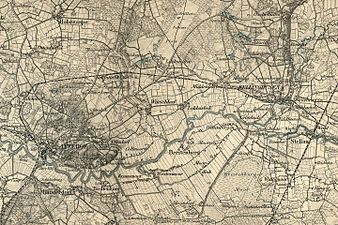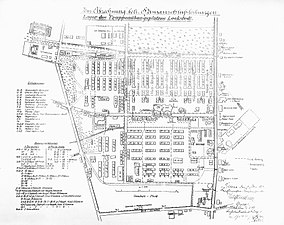Lockstedter warehouse

The Lockstedt camp (also called Lockstedt military training area ) was a manor district in Holstein used as a military training area , from which a community of the same name was formed in 1927 . During the Weimar Republic, the camp was a meeting point for right-wing extremist groups. The place was considered the cradle of the Schleswig-Holstein SA . Because of its bad reputation, the municipality changed its name to Hohenlockstedt in 1956 .
The military training area reached its greatest extent towards the beginning of the First World War , when it covered an area of about 60 km² on which up to 18,000 soldiers were stationed.
Maneuvering terrain
The maneuvering area was divided into the following exercise points : The village of Ridders was used to practice the offensive and defensive approach . From all directions of the compass rose of the church tower in Ridders this was determined as the march destination. On Peissner Pohl , on the Waldersee height and the Holsteiner Forest , the were shooting ranges . On Lesczinski-stone on which Bückener field , on Schierwaldenrath and Springhöh was in addition to the garrisons usual formations of the company , the battalion and regiment in brigade and what occurred less frequently in the Infantry Division marched .
The marching in divisional and corps formation took place rather during the imperial maneuvers .
History until the end of the First World War
The Lockstedter camp was established in 1872 as a training area for the IX. Army Corps of the Prussian Army established. In 1900 the German troop contingent to fight the Boxer Rebellion in China was set up here, under the leadership of Alfred Waldersee . In memory of this, a small wooded ridge bears the name Waldersee-Höhe.
In addition to the foot artillery regiment No. 20 , the new III. Battalion of the Schleswig-Holstein Infantry Regiment. 163 , which because of the not-yet finishing his barracks at the assigned location ( Heide ) Here vagabundierte , there's garrison .
From 1915 the Finnish hunters , Finnish war volunteers, who later formed the core of the Finnish army , were trained in the Lockstedt camp . This should support Finnish aspirations for autonomy and weaken Russia. As the Grand Duchy of Finland, Finland was part of the Russian Empire at that time . In 1917 Finland was able to gain independence with the help of these war volunteers.
- Lockstedter warehouse
Use from 1920
In 1920 - the military training area was actually supposed to be dissolved in accordance with the provisions of the Versailles Treaty - parts of the Ehrhardt Brigade were stationed in the Lockstedter Lager manor district , which had just before been a coup against the regular government in the Kapp Putsch . The unit should be peacefully dissolved and new work and accommodation should be found in settlement projects. The desired disarmament and depoliticization of the anti-republican and anti-Semitic legal associations did not succeed completely. Weapons were repeatedly found among the right-wing radical settlers. This caused a great deal of public attention and led to the Prussian Prime Minister Otto Braun visiting the camp in August 1920. But he gave the camp a good report card. But right-wing extremist activities continued. Shortly after Braun's visit in October, the settlers refused to voluntarily surrender weapons to the authorities. When a reward was paid for handing over weapons, the former members of the Ehrhardt Brigade delivered large quantities from their stocks. But that was only part of their supplies. As recently as 1923, large stocks of military weapons were found among settlers of the former Freikorpsverband . In addition, many of the former soldiers were not particularly suitable for the hard life of the settlers. As a result, the manor district has repeatedly been a base and refuge for anti-republican legal associations in Steinburg and throughout Schleswig-Holstein. These included the Holsteinische Elbmarsch riding clubs , the Black Reichswehr , the Stahlhelm and later the SA . In the following time, units of the Reichswehr - as part of the illegal Black Reichswehr - exercised on a smaller part of the military training area.
Hermann Ehrhardt founded the Bund Wiking in 1923 as the successor organization to the now banned murder organization Organization Consul , which was supposed to eliminate the republic by violent means. In nearby Itzehoe, the Wikingbund maintained a youth group controlled from Lockstedter camp, the Wiking Scouts . After the republican authorities had banned the Viking League, the youth group was renamed Freischar Schill . In 1927 she joined the NSDAP Hitler Youth under her leader Walter Bilkau .
Lockstedter Lager was considered the cradle of the Schleswig Holstein SA. From 1929 a so-called Volkssportschule worked for the SA and other right-wing extremist organizations , which, with the support of the Reich Board of Trustees for Military Training founded by General Kurt von Schleicher , functioned as a military sports school and provided large-scale paramilitary training. This training was part of the activities of the Black Reichswehr. The head of this military sports school, which held courses for right-wing extremist associations and especially for the SA, was the officer of the Black Reichswehr Herbert Selle , who was also a member of the SA and had already joined the NSDAP in 1920. In the 1930s the school was openly owned by the NSDAP. At first it functioned as an all-terrain sports school , from 1935 it was called the SA Sports School. Later a retraining facility of the SA was added, the SA-Hilfswerklager Nordmark , later SA-vocational school. Many functionaries of the Schleswig-Holstein National Socialists completed paramilitary courses in Locksteder's camp.
From 1936 an airfield was officially set up for the newly established air force on the “Hungry Wolf” sub- area. The army ammunition facility (Muna) was set up on the grounds of the Lockstedt camp as early as 1934 . This company expanded constantly. In 1944, 4,000 workers were employed there, including forced labor .
literature
- Reimer Möller, A coastal region in political and social upheaval (1860-1933): the consequences of industrialization in the Steinburg district (Elbe) . Hamburg, Münster 2007, ISBN 978-3-8258-9194-7 .
- Erwin Papke: The old Lockstedter Lager , in: Steinburger Jahrbuch 1994, pp. 73-82.
Web links
- Schleswig-Holstein from A to Z: Lockstedter Lager Society for Schleswig-Holstein History
- History of the camp in Hohenlockstedt-Info
- A military training area becomes arable land
Individual evidence
- ^ Ritter, Holger: History of the Schleswig-Holstein Infantry Regiment No. 163 ; Leuchtfeuer Verlag, Hamburg 1926, 418 pages, volume 184 of the Prussian. Share of the reminder sheets.
- ^ Reimer Möller, A coastal region in political and social upheaval (1860-1933): the consequences of industrialization in the Steinburg district (Elbe) . Hamburg, Münster 2007, ISBN 978-3-8258-9194-7 , pages 360–364.
- ^ Reimer Möller, A coastal region in political and social upheaval (1860-1933): the consequences of industrialization in the Steinburg district (Elbe) . Hamburg, Münster 2007, ISBN 978-3-8258-9194-7 , page 461 ff.
- ↑ Arnd Krüger & Frank v. Lojewski: Selected aspects of military sports in Lower Saxony during the Weimar period, in: H. LANGENFELD & S. NIELSEN (Ed.): Contributions to the history of sports in Lower Saxony. Part 2: Weimar Republic. (⇐ Series of publications by the Lower Saxony Institute for Sport History , Vol. 12) Hoya: NISH 1998, pp. 124–148.
Coordinates: 53 ° 58 ′ 9 ″ N , 9 ° 37 ′ 17 ″ E




